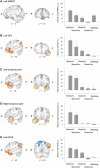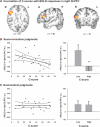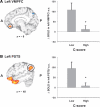Individual differences in moral judgment competence influence neural correlates of socio-normative judgments - PubMed (original) (raw)
Individual differences in moral judgment competence influence neural correlates of socio-normative judgments
Kristin Prehn et al. Soc Cogn Affect Neurosci. 2008 Mar.
Abstract
To investigate how individual differences in moral judgment competence are reflected in the human brain, we used event-related functional magnetic resonance imaging, while 23 participants made either socio-normative or grammatical judgments. Participants with lower moral judgment competence recruited the left ventromedial prefrontal cortex and the left posterior superior temporal sulcus more than participants with greater competence in this domain when identifying social norm violations. Moreover, moral judgment competence scores were inversely correlated with activity in the right dorsolateral prefrontal cortex (DLPFC) during socio-normative relative to grammatical judgments. Greater activity in right DLPFC in participants with lower moral judgment competence indicates increased recruitment of rule-based knowledge and its controlled application during socio-normative judgments. These data support current models of the neurocognition of morality according to which both emotional and cognitive components play an important role.
Figures
Fig. 1
Main effect of task. Left panel: Brain regions showing a main effect of task (socio-normative judgment vs grammatical judgment). Yellow-red regions responded more during socio-normative than during grammatical judgments, blue regions showed the reverse pattern (greater responses during grammatical than during socio-normative judgments). Results of group analysis (mixed effects analysis, n = 23) thresholded at Z = 3.09. Right panel: BOLD responses [mean and standard error of the mean in arbitrary units (a.u.), n = 23] during the five conditions (NormJ/v = violations of social norms, NormJ/nv = non-violations of social norms, GramJ/v = violations of grammatical rules, GramJ/nv = non-violations of grammatical rules, Reading = reading control task) in these regions. Analyses of BOLD responses in left VMPFC, right temporal pole and left PSTS were based on functional ROIs thresholded at Z = 3.09. Analyses in left OFC and left temporal pole were based on functional ROIs thresholded at Z = 3.89. All ROIs were clusters with a size of at least 28 voxels (cluster size corresponding to a corrected cluster threshold of P < 0.05).
Fig. 2
Moral judgment competence reflected in BOLD responses in right DLPFC. (A) Covariation of C-scores with BOLD responses in right DLPFC during socio-normative vs grammatical judgments [activation from higher level analysis thresholded at Z = 3.09 (P < 0.05, corrected)]. (B) Left panel: Negative correlation of C-scores and BOLD responses in right DLPFC during socio-normative judgments [r = −0.45; P = 0.03; C-scores plotted against BOLD responses in arbitrary units (a.u.) with regression line and 95% confidence limits]. Right panel: The subgroup with lower moral judgment competence (median split, n = 12) showed significantly greater activation in right DLPFC (mean and standard error of the mean) during socio-normative judgments than the subgroup with greater moral judgment competence (n = 11). (C) Left panel: No correlation of C-scores and BOLD responses in right DLPFC during grammatical judgments [r = −0.04; P = 0.64; C-scores plotted against BOLD responses in arbitrary units (a.u.) with regression line and 95% confidence limits]. Right panel: No difference in BOLD responses (mean and standard error of the mean) between the two subgroups during grammatical judgments.
Fig. 3
Moral judgment competence modulates BOLD responses in regions involved in socio-normative judgments. BOLD responses in (A) left VMPFC and (B) left PSTS during identification of social norm violations [activation from higher level analysis thresholded at Z = 3.09 (P < 0.05, corrected) based on functional ROIs thresholded at Z = 3.09]. Participants with lower moral judgment competence (median split, n = 12) showed significantly greater activation (mean and standard error of the mean) than participants with higher moral judgment competence (n = 11).
Similar articles
- Individual differences in moral judgment competence are related to activity of the prefrontal cortex when attributing blame to evil intention.
Li X, Yang J, Li P, Li H. Li X, et al. Soc Neurosci. 2016;11(4):438-48. doi: 10.1080/17470919.2015.1093960. Epub 2015 Nov 16. Soc Neurosci. 2016. PMID: 26569419 - Neural correlates of moral goodness and moral beauty judgments.
Cheng Q, Cui X, Lin J, Weng X, Mo L. Cheng Q, et al. Brain Res. 2020 Jan 1;1726:146534. doi: 10.1016/j.brainres.2019.146534. Epub 2019 Oct 24. Brain Res. 2020. PMID: 31669285 - From moral to legal judgment: the influence of normative context in lawyers and other academics.
Schleim S, Spranger TM, Erk S, Walter H. Schleim S, et al. Soc Cogn Affect Neurosci. 2011 Jan;6(1):48-57. doi: 10.1093/scan/nsq010. Epub 2010 Mar 1. Soc Cogn Affect Neurosci. 2011. PMID: 20194515 Free PMC article. - Investigating emotion in moral cognition: a review of evidence from functional neuroimaging and neuropsychology.
Young L, Koenigs M. Young L, et al. Br Med Bull. 2007;84:69-79. doi: 10.1093/bmb/ldm031. Epub 2007 Nov 20. Br Med Bull. 2007. PMID: 18029385 Review. - [On the necessity to distinguishing judgment from subjective choice in the cognitive neuroscience of morality].
Tassy S. Tassy S. Med Sci (Paris). 2011 Oct;27(10):889-94. doi: 10.1051/medsci/20112710018. Epub 2011 Oct 21. Med Sci (Paris). 2011. PMID: 22027427 Review. French.
Cited by
- How does morality work in the brain? A functional and structural perspective of moral behavior.
Pascual L, Rodrigues P, Gallardo-Pujol D. Pascual L, et al. Front Integr Neurosci. 2013 Sep 12;7:65. doi: 10.3389/fnint.2013.00065. Front Integr Neurosci. 2013. PMID: 24062650 Free PMC article. Review. - TMS affects moral judgment, showing the role of DLPFC and TPJ in cognitive and emotional processing.
Jeurissen D, Sack AT, Roebroeck A, Russ BE, Pascual-Leone A. Jeurissen D, et al. Front Neurosci. 2014 Feb 13;8:18. doi: 10.3389/fnins.2014.00018. eCollection 2014. Front Neurosci. 2014. PMID: 24592204 Free PMC article. - Architecture of explanatory inference in the human prefrontal cortex.
Barbey AK, Patterson R. Barbey AK, et al. Front Psychol. 2011 Jul 27;2:162. doi: 10.3389/fpsyg.2011.00162. eCollection 2011. Front Psychol. 2011. PMID: 21845182 Free PMC article. - The neurobiology of moral behavior: review and neuropsychiatric implications.
Mendez MF. Mendez MF. CNS Spectr. 2009 Nov;14(11):608-20. doi: 10.1017/s1092852900023853. CNS Spectr. 2009. PMID: 20173686 Free PMC article. Review. - Moral reasoning and moral competence as predictors of cooperative behavior in a social dilemma.
Miranda-Rodríguez RA, Leenen I, Han H, Palafox-Palafox G, García-Rodríguez G. Miranda-Rodríguez RA, et al. Sci Rep. 2023 Mar 6;13(1):3724. doi: 10.1038/s41598-023-30314-7. Sci Rep. 2023. PMID: 36878921 Free PMC article.
References
- Amodio DM, Frith CD. Meeting of minds: the medial frontal cortex and social cognition. Nature Reviews Neuroscience. 2006;7:268–77. - PubMed
- Anderson SW, Bechara A, Damasio H, Tranel D, Damasio AR. Impairment of social and moral behavior related to early damage in human prefrontal cortex. Nature Neuroscience. 1999;2:1032–7. - PubMed
- Baayen RH, Piepenbrock R, Rijn H. The CELEX Lexical Database [CD-ROM] (Release 1) Philadelphia, PA: Linguistic Data Consortium, University of Pennsylvania; 1993.
- Beauchamp MS, Lee KE, Argall BD, Martin A. Integration of auditory and visual information about objects in superior temporal sulcus. Neuron. 2004;41:809–23. - PubMed
- Beauchamp MS, Lee KE, Haxby JV, Martin A. Parallel visual motion processing streams for manipulable objects and human movements. Neuron. 2002;34:149–59. - PubMed
Publication types
MeSH terms
Substances
LinkOut - more resources
Full Text Sources


